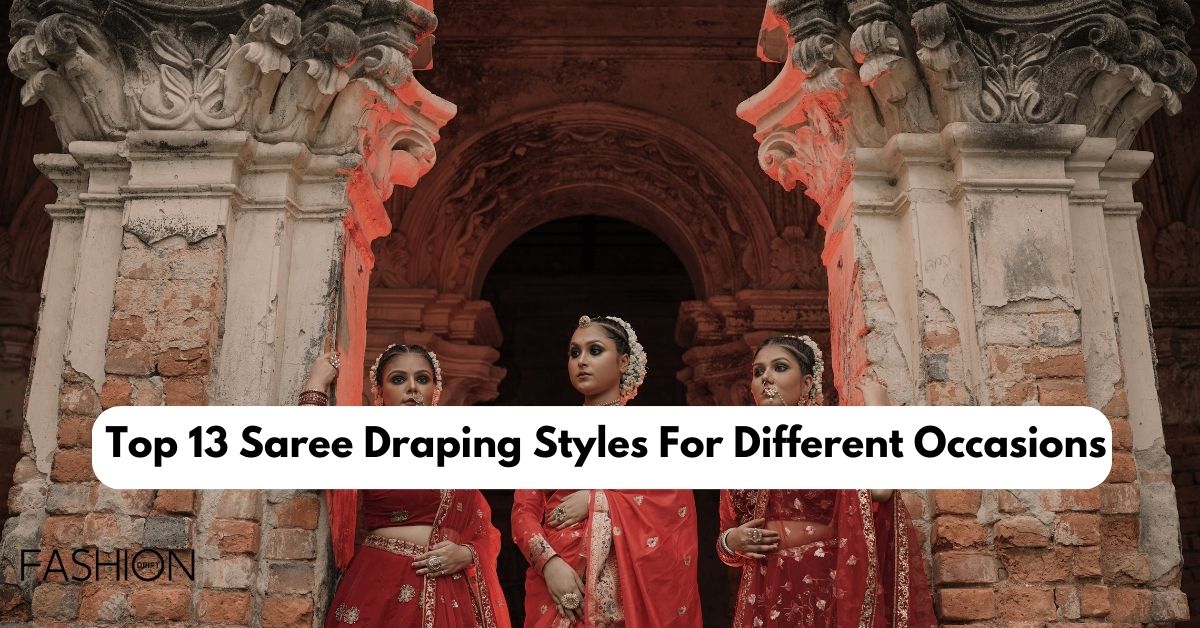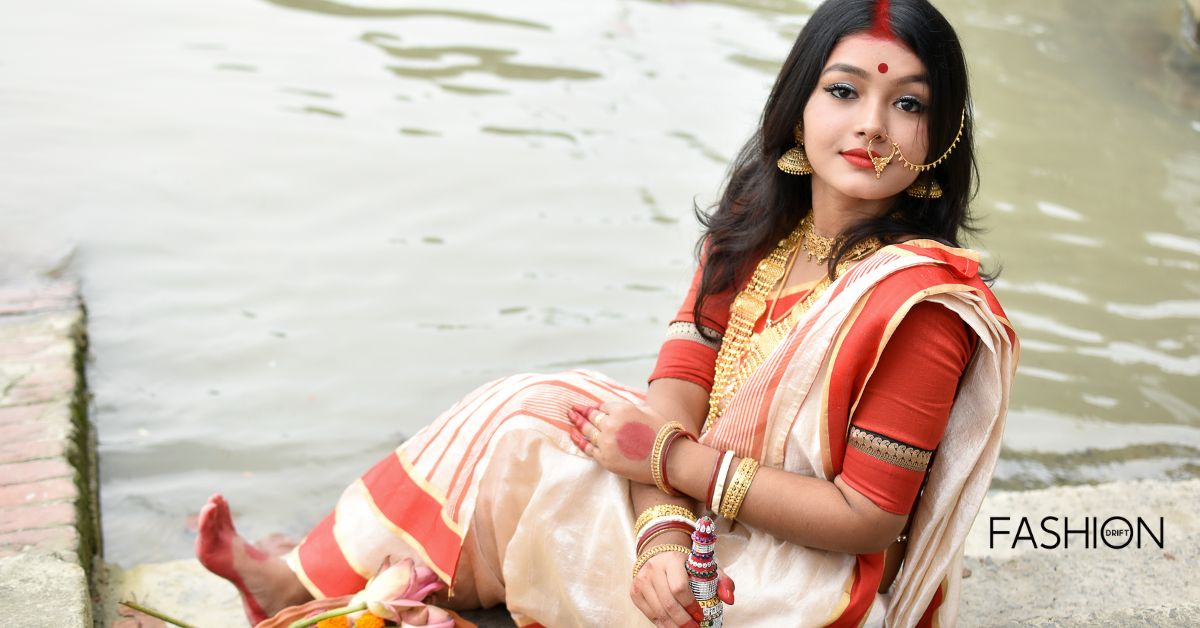
As a woman, there are few things more beautiful and elegant than a saree. This traditional Indian garment has been worn for centuries and continues to be a popular choice for formal events, weddings, and other special occasions. However, with so many different styles of saree draping out there, it can be difficult to know which one to choose.
In this blog post, I’ll be sharing the top 13 saree draping styles for different occasions. Whether you’re attending a wedding, a formal event, or just want to wear a saree for a day out, there’s a draping style that’s perfect for you.
Nivi Style
The Nivi style is the most common and popular way to drape a saree. It’s a simple and elegant style that’s perfect for any occasion. To drape a saree in the Nivi style, you simply tuck one end of the saree into your waistband, bring it around your back, and drape it over your left shoulder.
Bengali Style
 The Bengali style is a beautiful and traditional way to drape a saree. It’s characterized by a lot of draping and pleating and is often worn with a big red bindi on the forehead. To drape a saree in the Bengali style, you’ll need to create a lot of pleats and drape the pallu over your left shoulder.
The Bengali style is a beautiful and traditional way to drape a saree. It’s characterized by a lot of draping and pleating and is often worn with a big red bindi on the forehead. To drape a saree in the Bengali style, you’ll need to create a lot of pleats and drape the pallu over your left shoulder.
Gujarati Style
The Gujarati style is a unique and colorful way to drape a saree. It’s characterized by a lot of pleating and draping and is often worn with a big nose ring and a lot of jewelry. To drape a saree in the Gujarati style, you’ll need to create a lot of pleats and drape the pallu over your right shoulder.
Maharashtrian Style
The Maharashtrian style is a simple and elegant way to drape a saree. It’s characterized by a lot of draping and a unique drape on the back. To drape a saree in the Maharashtrian style, you’ll need to create a lot of pleats and drape the pallu over your left shoulder.
Tamilian Style
 The Tamilian style is a simple and elegant way to drape a saree. It’s characterized by a lot of draping and a unique drape on the back. To drape a saree in the Tamilian style, you’ll need to create a lot of pleats and drape the pallu over your left shoulder. The saree is draped in such a way that it covers the head and falls over the right shoulder. This style is perfect for formal events and weddings.
The Tamilian style is a simple and elegant way to drape a saree. It’s characterized by a lot of draping and a unique drape on the back. To drape a saree in the Tamilian style, you’ll need to create a lot of pleats and drape the pallu over your left shoulder. The saree is draped in such a way that it covers the head and falls over the right shoulder. This style is perfect for formal events and weddings.
Mumtaz Style
The Mumtaz style is a vintage style that was made popular by the Bollywood actress Mumtaz in the 60s. It’s characterized by a lot of draping and a unique drape on the back. To drape a saree in the Mumtaz style, you’ll need to create a lot of pleats and drape the pallu over your left shoulder. The saree is draped in such a way that it covers the head and falls over the right shoulder, creating a beautiful and elegant look.
Butterfly Style
The Butterfly style is a modern and trendy way to drape a saree. It’s characterized by a lot of draping and a unique drape on the back. To drape a saree in the Butterfly style, you’ll need to create a lot of pleats and drape the pallu over your left shoulder. The saree is draped in such a way that it creates a butterfly-like shape on the back, hence the name.
Lehenga Style
The Lehenga style is a popular way to drape a saree for weddings and other formal events. It’s characterized by a lot of draping and a unique drape on the back. To drape a saree in the Lehenga style, you’ll need to create a lot of pleats and tuck the saree into your waistband, creating a skirt-like effect. The pallu is draped over the left shoulder, creating a beautiful and elegant look.
Want to look thin? Check this article.
Half Saree Style
The Half Saree style is a popular way to drape a saree for young girls and teenagers. It’s characterized by a lot of draping and a unique drape on the back. To drape a saree in the Half Saree style, you’ll need to create a lot of pleats and tuck the saree into your waistband, creating a skirt-like effect. The pallu is draped over the left shoulder, creating a beautiful and elegant look. This style is perfect for young girls and teenagers who want to wear a saree but don’t want to look too formal.
Mermaid Style
The Mermaid style is a modern and trendy way to drape a saree. It’s characterized by a lot of draping and a unique drape on the back. To drape a saree in the Mermaid style, you’ll need to create a lot of pleats and tuck the saree into your waistband, creating a skirt-like effect. The pallu is draped over the left shoulder, creating a beautiful and elegant look. This style is perfect for cocktail parties and other formal events.
Rajrani Style
The Rajrani style is a regal and elegant way to drape a saree. It’s characterized by a lot of draping and a unique drape on the back. To drape a saree in the Rajrani style, you’ll need to create a lot of pleats and tuck the saree into your waistband, creating a skirt-like effect. The pallu is draped over the left shoulder, creating a beautiful and elegant look. This style is perfect for weddings and other formal events.
Dhoti Style
The Dhoti style is a unique and trendy way to drape a saree. It’s characterized by a lot of draping and a unique drape on the back. To drape a saree in the Dhoti style, you’ll need to create a lot of pleats and tuck the saree into your waistband, creating a dhoti-like effect. The pallu is draped over the left shoulder, creating a beautiful and elegant look. This style is perfect for fashion-forward women who want to make a statement.
Seedha Pallu Style
The Seedha Pallu style is a simple and elegant way to drape a saree. It’s characterized by a lot of draping and a unique drape on the back. To drape a saree in the Seedha Pallu style, you’ll need to create a lot of pleats and drape the pallu over your right shoulder. This style is perfect for formal events and weddings.
Conclusion
There are many different ways to drape a saree, and each style has its own unique characteristics and is perfect for different occasions. Whether you’re attending a wedding, a formal event, or just want to wear a saree for a day out, there’s a draping style that’s perfect for you.





Comments (1)
IanSsays:
08/07/2024 at 14:53Very interesting info!Perfect just what I was searching for!Blog monetyze